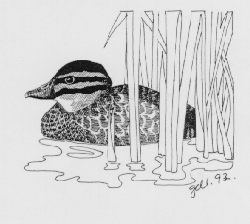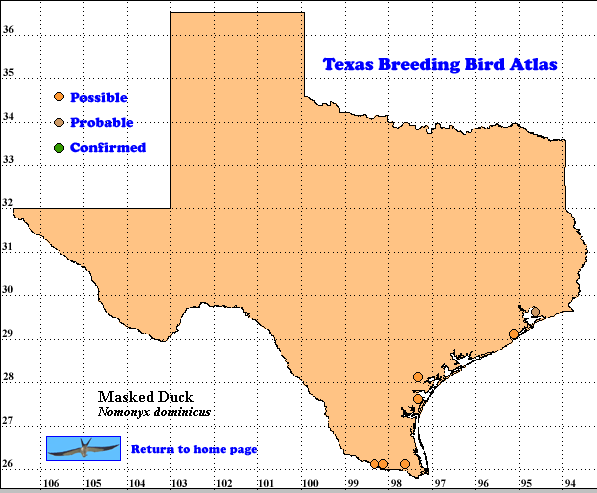Nomonyx dominica
The Masked Duck, an elusive tropical relative of the Ruddy Duck (Oxyura jamaicensis), inhabits heavily overgrown swamps, marshes and ponds. Besides being secretive, these ducks are usually found singly. Masked Ducks generally do not congregate except during the nesting season (Gomez-Dallmeier & Cringan 1989, Johnsgard & Carbonell 1996).
DISTRIBUTION: Although a common resident of South America, the Masked Duck is considered to be uncommon throughout most of Central America and North America. Historically, sightings have been recorded along the coastal plain of Texas from Hidalgo and Cameron Counties (in latilongs 25097 and 26097) northward to Chambers County (latilong 29094). Most sightings are believed to be of wintering or wandering birds. Of the 12 records occurring during the TBBAP years, only one, at Welder Wildlife Refuge (28097-A4), resulted in documented breeding.
SEASONAL OCCURRENCE: Not surprisingly, atlasers found little evidence of breeding by Masked Ducks during the TBBAP years. However, nesting attempts in Texas date from April to November (Oberholser 1974). Masked Ducks occurring in suitable habitat during this “known” breeding season produced the possible breeding records shown on the map. The 6 Masked Ducks observed at Welder Wildlife Refuge (28097-A4) on 8 October 1992 provided a possible breeding record initially. A confirmed record at that location subsequently occurred in June 1993 (post-TBBAP), when Blankenship & Anderson (1993) discovered a “nest under construction”. Numerous other sightings and some breeding records led Haynie (1993) to report that “a large incursion of Masked Ducks (was) witnessed during 1992 and 1993” in Texas. Two other confirmed breeding records occurred post -TBBAP.
At least one pair nested successfully at a private location on San Patricio County (27097); a female with 5 ducklings was observed on 21 August 1993 (fide T. Blankenship 1994). And 14 adults with 10 young were at Attwater Prairie Chicken NWR in Colorado County (29096-F3) in July-December 1994 (Haynie 1998).
BREEDING HABITAT: Nests, when found, are most often in small lagoons or resacas (Oberholser 1974). They are usually among vegetation such as cordgrass (Spartina sp.), rushes (Scirpus sp.), or cattails (Typha latifolia). Blankenship and Anderson (1993) found the Welder Wildlife Refuge nest in a clump of spiny aster (Leucosyris spinosa). Nests are roofed over and basketball-like (Johnsgard & Carbonell 1996). Clutch size is four to six eggs (Eitniear 1999).
STATUS: Anderson et al. (1998) estimated the population of Masked Ducks in Texas to be approximately 3,800 birds. This small population size coupled with the species predilection for inaccessible, marshy habitats make determination of actual breeding status difficult. The steady trickle of sightings (with occasional confirmed nestings) over the years however, indicates that this duck must be regarded as a rare resident along the coast of Texas.
Text by Jack Eitniear (ca. 2000)
Literature cited
Anderson, J. T., G. T. Muehl, and T. C. Tacha. 1998. Distribution and abundance of waterbirds in coastal Texas. Bird Pop.4: 1-15.
Anderson, J. T. and T. C. Tacha . 1999. Habitat use by Masked Ducks along the gulf coast of Texas. Wilson Bull. 111: 119-121.
Blankenship, T. L. 1994. South Texas summer records. Am. Birds 48: 128.
Blankenship, T. L., and J. T. Anderson. 1993. A large concentration of Masked Ducks (Oxyura dominica) on the Welder Wildlife Refuge, San Patricio County, Texas. Bull. Texas Ornithol. Soc. 26: 19-21.
Eitniear, J. C. 1999. Masked Duck (Nomonyx dominica). n The birds of North America, No. 393 (A. Poole and F. Gill, eds.). The Birds of North America, Inc. Philadelphia, PA.
Gomez-Dallmeier, F. and A. Cringan. 1990. Biology, conservation and management of waterfowl in Venezuela. Editorial Ex Libris, Caracas.
Haynie, C. B. 1993. Texas Bird Records Committee report for 1993. Bull. Texas Ornithol. Soc. 26: 2-14.
Haynie, C. B. 1998. Texas Bird Records Committee report for 1996. Bull. Texas Ornithol. Soc. 31: 7-21.
Johnsgard, P. A., and M. Carbonell. 1996. Ruddy Ducks and other Stifftails. University of Oklahoma Press, Norman.
Oberholser, H. C. 1974. The bird life of Texas. University of Texas Press, Austin.

